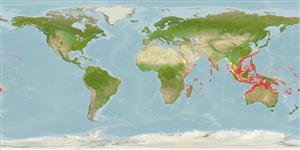Classification / Names
Common names | Synonyms | Catalog of Fishes (gen., sp.) | ITIS | CoL | WoRMS | Cloffa
Environment / Climate / Range
Ecology
Marine; reef-associated; depth range 0 - 170 m (Ref. 89055), usually ? - 90 m (Ref. 9840). Tropical, preferred ?; 33°N - 33°S, 28°E - 154°W
Indo-Pacific: Red Sea (Ref. 9840) and East Africa to Samoa (Ref. 592) and Tonga (Ref. 53797), north to Japan, south to Australia (Ref. 9840). Represented by multiple color morphs in the Indo-Pacific which may be different species (Ref. 9840).
Length at first maturity / Size / Weight / Age
Maturity: Lm 27.6, range 12 - 46.5 cm
Max length : 70.0 cm TL male/unsexed; (Ref. 5578)
Dorsal
spines
(total): 0;
Dorsal
soft rays
(total): 0;
Anal
spines: 0;
Anal
soft rays: 0. Reddish brown with blue centered bright ocelli and scattered black spots dorsally, white ventrally (Ref. 3263). Snout very short and broadly angular; disc angular; tail as long as body with conspicuous black and white rings, and with a short upper caudal finfold but a longer lower one ending well behind tail tip; disc without thorns; usually one sting on tail (Ref. 5578).
A solitary species found on sandy bottoms near rocky or coral reefs (Ref. 12951). Usually found in deeper water but moves onto the reef flat and into shallow lagoons at high tide (Ref. 12951). Occasionally covers itself with sand, leaving only its eyes and tail visible (Ref. 37816). Feeds on crabs and shrimps (Ref. 5578). Ovoviviparous (Ref. 50449). The venomous spine can inflict a painful wound (Ref.4690). Caught in very large quantities in the bottom trawl, trammel and fish trap fisheries. Utilized for its meat but of limited value due to its small size (Ref.58048).
Exhibit ovoviparity (aplacental viviparity), with embryos feeding initially on yolk, then receiving additional nourishment from the mother by indirect absorption of uterine fluid enriched with mucus, fat or protein through specialised structures (Ref. 50449). Distinct pairing with embrace (Ref. 205). Litters size at birth 16 cm (Ref. 37816); Java form born at 11-16 cm WD, Bali form born at ~17 cm WD. Gives birth to litters of 1-2 pups; no reproductive synchronicity (Ref. 58048).
Compagno, L.J.V., 1986. Dasyatidae. p. 135-142. In M.M. Smith and P.C. Heemstra (eds.) Smiths' sea fishes. Springer-Verlag, Berlin. (Ref. 3263)
IUCN Red List Status (Ref. 115185)
CITES (Ref. 94142)
Not Evaluated
Human uses
Fisheries: commercial
More information
ReferencesAquacultureAquaculture profileStrainsGeneticsAllele frequenciesHeritabilityDiseasesProcessingMass conversion
Tools
Special reports
Download XML
Internet sources
Estimates of some properties based on models
Phylogenetic diversity index (Ref.
82805): PD
50 = 0.5312 [Uniqueness, from 0.5 = low to 2.0 = high].
Bayesian length-weight: a=0.01096 (0.00530 - 0.02268), b=3.10 (2.92 - 3.28), in cm Total Length, based on LWR estimates for this species & (Sub)family-body (Ref.
93245).
Trophic Level (Ref.
69278): 3.3 ±0.3 se; Based on diet studies.
Resilience (Ref.
69278): Very Low, minimum population doubling time more than 14 years (Fec=1-3).
Vulnerability (Ref.
59153): Moderate to high vulnerability (52 of 100) .
